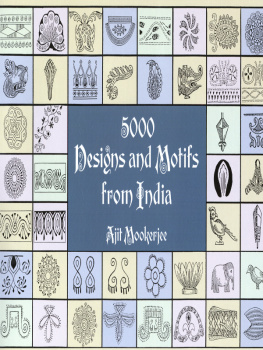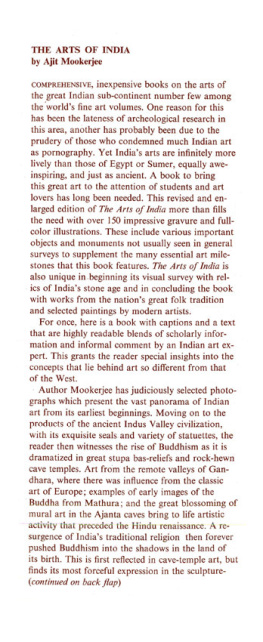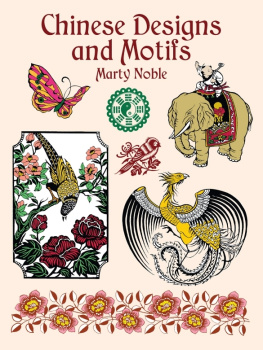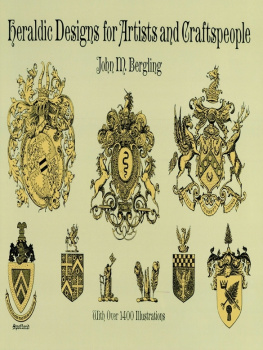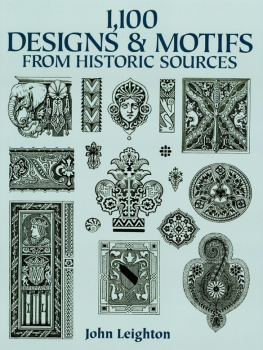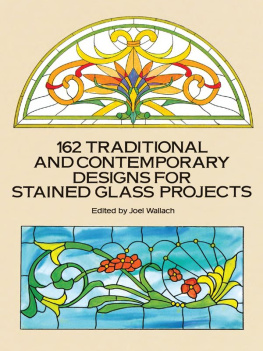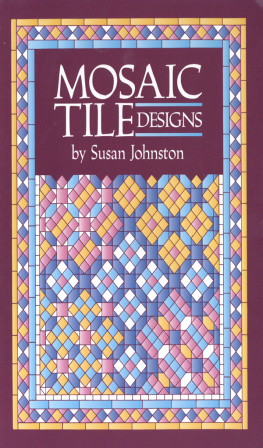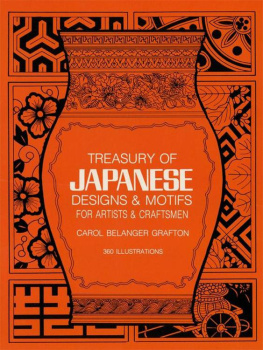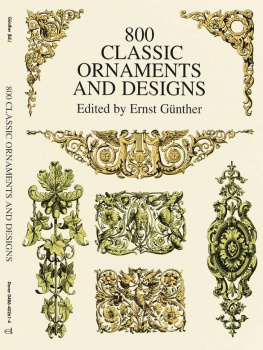Ajit Mookerjee - 5000 Designs and Motifs from India
Here you can read online Ajit Mookerjee - 5000 Designs and Motifs from India full text of the book (entire story) in english for free. Download pdf and epub, get meaning, cover and reviews about this ebook. year: 2013, publisher: INscribe Digital;Dover Publications, genre: Art. Description of the work, (preface) as well as reviews are available. Best literature library LitArk.com created for fans of good reading and offers a wide selection of genres:
Romance novel
Science fiction
Adventure
Detective
Science
History
Home and family
Prose
Art
Politics
Computer
Non-fiction
Religion
Business
Children
Humor
Choose a favorite category and find really read worthwhile books. Enjoy immersion in the world of imagination, feel the emotions of the characters or learn something new for yourself, make an fascinating discovery.
- Book:5000 Designs and Motifs from India
- Author:
- Publisher:INscribe Digital;Dover Publications
- Genre:
- Year:2013
- Rating:4 / 5
- Favourites:Add to favourites
- Your mark:
- 80
- 1
- 2
- 3
- 4
- 5
5000 Designs and Motifs from India: summary, description and annotation
We offer to read an annotation, description, summary or preface (depends on what the author of the book "5000 Designs and Motifs from India" wrote himself). If you haven't found the necessary information about the book — write in the comments, we will try to find it.
Incredibly rich treasury of authentic royalty-free designs adapted from artifacts of the Harappa culture, coins and pottery from South India, Ajanta and Bagh murals, Muslim monuments, Buddhist temples, textiles from Gujarat, Punjab, other regions, masks and tribal arts, much more. Immediately usable material or great resource for design inspiration. Introduction. Notes.
5000 Designs and Motifs from India — read online for free the complete book (whole text) full work
Below is the text of the book, divided by pages. System saving the place of the last page read, allows you to conveniently read the book "5000 Designs and Motifs from India" online for free, without having to search again every time where you left off. Put a bookmark, and you can go to the page where you finished reading at any time.
Font size:
Interval:
Bookmark:
5,000 Designs and Motifs from India Edited by AJIT MOOKERJEE DOVER PUBLICATIONS, INC.
Mineola New York Bibliographical Note This Dover edition, first published in 1996, is an unabridged, slightly corrected republication of the work first published by The Indian Institute of Art in Industry: Artistry House, Calcutta, India, in 1958, under the title 5000 Indian Designs and Motifs. The publisher is grateful to Duke University for making their copy of this book available for reprinting. Library of Congress Catalogin g-in-Publication Data 5000 designs and motifs from India 5000 Indian designs and motifs edited by Ajit Mookerjee p. cm. Includes index. ISBN-13: 978-0-486-29061-4 (pbk.) ISBN-10: 0-486-29061-1 (pbk.) 1.
Decoration and ornamentIndiaThemes, motives. I. Mookerjee, Ajit. II. Title. NK1476.A1A18 1996
745.44954dc20 96-11366 CIP Manufactured in the United States by Courier Corporation 29061107 www.doverpublications.com FOREWORD T HE ILLUSTRATIONS presented in this book have been selected from different sources as typical of Indian traditional designs and motifs.
In spite of their variety and complexity, an unerring thread of continuity, growing out of the inner logic and dynamism of the people from region to region, connects these elements. These designs and motifs may be a great source of inspiration to the designer-artist who can take full advantage of them. All such designs have a special Indian quality and the designer-artist should be at home with themand through them, with the treasures of India. Our principal aim in presenting them in book form is to offer a glimpse into the rich store of Indian decorative art. I wish to express my thanks to Mr. R. R.
Gopalakrishnan and to Mr. Gouri Ghose for their cooperation and particularly to the three artists, Miss Arati Roy, Mr. Indu Bhusan Gupta and Mr. Sushil Das, for the copy work. I am also grateful to Dr. A. M. M.
NOTES TRADITIONAL DESIGNS AND MOTIFS : 3000 B . C. TO MODERN TIMES Harappa culture: mainly Mohenjo-daro and Harappa seals, dolls and toys, pottery including Nal Sanchi Stupas: mainly railings and gateways Punch-marked coins and pottery: mainly Taxila and South India Ajanta and Bagh murals Muslim monuments: mainly Agra, Delhi, Sikandra, Fatehpur Sikri, Bijapur, Lahore, Jaunpur, etc. Buddhist, Jain and Brahminical temples Jewellery and metal wares: mainly Rajasthan, South India, including folk specimens Textiles: wovenmainly Banaras, Orissa, Dacca, Gujarat, Maharashtra; printedmainly Jaipur, Murshidabad, South India, Gujarat; embroideredmainly Punjab, Saurashtra, Himachal Pradesh, Hyderabad, Assam, Manipur, including Bengal Kanthas Paintings and drawings: mainly Orissa, Bengal, Rajasthan including Alpana, Kolam and Kasoti Miscellaneous items including migration of Indian motifs Masks and tribal arts: mainly Orissa, Naga, Bengal and Madhya Pradesh INTRODUCTION A RT is applied life. India, which has had a rich and varied existence for thousands of years, has naturally come to inherit a unique art tradition. Indian art in its distinctive form is now increasingly being recognized as worthy of study and appreciation.
Universal in character, it has at the same time its own well-defined features, influencing, and being influenced by, other forms of art. Indian decorative art as a special subject of study has not yet been taken up seriously although random references to it in many of the books and treatises on the broader subject of Indian art have served to invite more attention to it. Decoration is part of any object of art and as such is discussed often along with its integral quality. A separate study of this area is warranted because of its adaptability for modem application. Modem designing in India is a recent trend and, with a growing appreciation of its values, designers are apt to look back to traditional forms and to contemporary developments for their inspiration and sustenance with equal measure. To help such designers (and others interested in the subject) this modest publication is attempted.
In application of designs, the artists of old seldom lost their sense of proportion and balance and the main theme of the work was never lost sight of in the exuberance of decoration. Degeneration followed as a later phenomenon. Indian art in general, no doubt, provides adequate material for the study of decorative arts. But it is in the actual articles of daily use or other ancillary objects that the designs and motifs are so well preserved and handed down from generation to generation. A study of Indian art from a purely aesthetic point of view will reveal that over a wide field, in the artistic sensibility of the people, there is a surprising continuity from one epoch to another. The basic continuity is not achieved at the sacrifice of flexibility of forms and designs.
On the other hand, the popular standard of taste has been maintained throughout because of the scope for such transformation and change. This continuity is, however, not like that of a stagnant pool. So long as the craftsman functioned and he set his personal seal on the things he produced, there was no risk of any violent change in their appeal nor was there any sudden break with the past. Art was conditioned by the function of the craft object, which in turn guided the life movement of the people in any given surrounding. In other words, decoration was a part of the function; it grew from within and was seldom imposed externally. Artistic skill was not acquired, but inborn; art and life went hand in hand for they were never thought of separately.
As life was conditioned by religion, customs and codes, so too were arts and crafts. Conflict could not arise because an alternative social structure did not present itself until the industrial age. The revolutionary change brought about by industrialization could not be an easy one. Old values crumbled and, because no new values could be readily found, there was the inevitable sense of frustration. When the craftsman of old disappeared the standards set by him vanished with him. Yet the machine which took his place failed to guide popular sensibility or to produce any aesthetic standard.
In the place of the quality products by the craftsman, the machine took charge and substituted quantity. Where the one excelled in individuality and personal touch, the other went by sheer number and anonymity. When production on a large scale became possible by the use of the machine, the products were characterless. The craftsman who inherited the group soul or the sum total of artistic consciousness preceding him, functioned at his best when both his material and spiritual satisfaction were assured by society. Coomaraswamy says, It has only been when the craftsman has had the right to work, the right to work faithfully, a right to the due reward of his labour, and at the same time a conscious or subconscious faith in the social and spiritual significance of his work, that his art possessed the elements of real greatness. In the cataclysm that industrialization brought about, both these elements, so conducive to greatness in art and craft in the preceding ages, were lost to the craftsman.
As a factory hand, his material condition worsened and, more than that, he lost the dignity and status which went unsolicited to him in a village economy. Industrialization also meant a division of labour so complete yet up to the time quite unknown. The craftsman was both the designer and the manufacturer and was therefore free to set a standard for himself in his craft. Industrialization cut these two into a number of different compartments and, in any event, the craftsman played an insignificant role in a complicated process. Moreover, as the designer and the manufacturer combined in the traditional craftsman, he could command the shape, form, colour, etc. of the product.
The modem age may be incapable of recreating the past. The machine has entered so much in our life and it promises to be more emphatic in the days of the future. There is, on the other hand, the chance of evolving a new and abiding culture by the judicial integration of machine and handicraft. In the present context, judicial integration means instillation of a sense of design in the manufacturing process so that we recapture a little of that colour and form in the things of everyday use which were so characteristic in the days of the craftsman. A mere copying of the past, however adept, will not help; for that past was conditioned by so many factors that have since vanished. Moreover, what will predominantly guide the design movement in the present and the future is science.
Next pageFont size:
Interval:
Bookmark:
Similar books «5000 Designs and Motifs from India»
Look at similar books to 5000 Designs and Motifs from India. We have selected literature similar in name and meaning in the hope of providing readers with more options to find new, interesting, not yet read works.
Discussion, reviews of the book 5000 Designs and Motifs from India and just readers' own opinions. Leave your comments, write what you think about the work, its meaning or the main characters. Specify what exactly you liked and what you didn't like, and why you think so.

